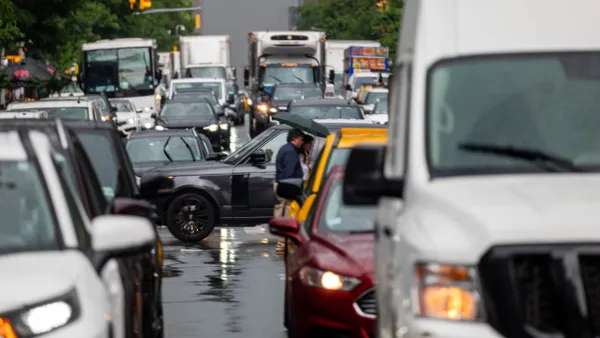Dive Brief:
- Communities in the Greater Miami area banded together to create a regional resilience strategy, Resilient305. The effort is a collaboration between the cities of Miami and Miami Beach, Miami-Dade County (comprised of 34 cities), The Miami Foundation and 100 Resilient Cities.
Today, we launched the #Resilient305 Strategy! Together with @100ResCities, @MiamiFoundation, @MiamiDadeCounty, & @MiamiBeachNews, this marks a milestone for our efforts to combat everything from sea level rise to job creation, & serves as a model of collaboration for the world. pic.twitter.com/JA4VdCDTjY
— Mayor Francis Suarez (@MiamiMayor) May 30, 2019 - Resilient305 contains more than 50 actions focused on issues such as the environment, infrastructure and economic prosperity. Some of the measures address mobility, housing options, energy efficiencies, financial stability and advancing public health priorities.
- In April, Resilient305 was named one of the first winners of JP Morgan Chase's AdvancingCities Challenge, and will receive $3 million over a three-year period.
Dive Insight:
As with other resilience plans, Resilient305 aims to better equip the city and citizens for bouncing back from major shocks and daily stressors. The challenges can be natural or manmade, such as hurricanes or the 2008 mortgage crisis.
Environmental concerns make up a significant portion of the resilience plan. It notes the sea level off Miami and Miami Beach has risen four inches since 1992, and it's expected to rise another three to seven inches by 2030.
The concern is particularly acute in Miami Beach, which is a coastal island and could be underwater sooner than the mainland. South Florida regularly experiences worsening flooding from "king tides," which arrive based on lunar and tide schedules even if it hasn't rained; the tides cause the ocean to swell and spill salt water into city streets. King tides are said to be the result of climate change.
Resilient305 addresses climate change and environmental issues not just for the safety and well-being of its residents, but also because the area's natural beauty and wildlife are a huge tourism draw and economic boon.
Climate change is blamed for king tides, rising air temperatures and reef bleaching, but the effects grow drastically when a natural disaster such as a hurricane ravages the area. Without advance planning, hurricane recovery can become an overwhelming challenge. The resilience strategy also stresses the importance of pre-planning for post-disaster recovery.
South Florida was hit particularly hard when the housing bubble burst in 2008. The resilience plan says Miami-Dade County experienced 79,000 foreclosures as a result.
Cities suddenly lost huge amounts of property tax revenue and had to cut back on services. Resilient305 states the financial crisis taught the region to better diversify economies and revenue sources. It contains actions to bolster job growth and wealth creation and retention.
The mortgage crisis plays into decreasing housing affordability in Miami-Dade County. The housing market is also disproportionately influenced by foreign investments in housing, which drives up costs for citizens as investment properties sit vacant.
A report this spring indicates Miami needs to build or preserve 50,000 housing units to meet the existing need. Housing affordability and the environment are two of the areas for which the Knight Foundation granted $1 million to the Harvard University Graduate School of Design for a three-year study to create solutions for sustainability and resiliency challenges facing the region.
Resilient305 bears similarities to other resilience plans, but it's unique in its collaborative, regional approach.
More city leaders are forging partnerships with neighboring communities because they realize that big problems don't see municipal borders. Issues like pollution, traffic congestion and housing affordability inevitably spill over from big cities to surrounding areas. Pooling ideas and resources can help a region become stronger and more resilient.











